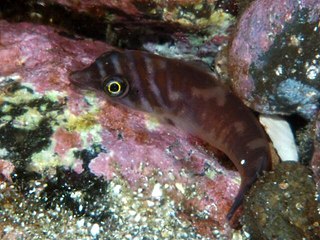
Clingfishes are fishes of the family Gobiesocidae, the only family in the order Gobiesociformes. These fairly small to very small fishes are widespread in tropical and temperate regions, mostly near the coast, but a few species in deeper seas or fresh water. Most species shelter in shallow reefs or seagrass beds, clinging to rocks, algae and seagrass leaves with their sucking disc, a structure on their chest.
Hector's clingfish, Gastroscyphus hectoris, is a clingfish of the family Gobiesocidae, the only species in the genus Gastrocyathus. It is found all down the east coast of New Zealand around the low water mark amongst seaweed, on rocky coastlines. Its length is up to 6.4 centimetres (2.5 in) SL. This species was described in 1876 by Albert Günther as Crepidogaster hectoris from a holotype collected on the south shore of the Cook Strait. Günther honoured the Scottish-born scientist James Hector (1834-1907) who was the Director of the Geological Survey of New Zealand and who presented type to the British Museum.
The giant clingfish, Haplocylix littoreus, is a clingfish of the family Gobiesocidae, the only species in the genus Haplocylix. It is found all down the east coast of New Zealand around the low water mark amongst seaweed, on rocky coastlines. Its length is up to 15 centimetres (5.9 in). This species was originally described as Cyclopterus littoreus in 1801 by Johann Reinhold Forster, John C. Briggs subsequently placed it in the monotypic genus Haplocylix. Its closest relative appears to be the Caribbean deepwater clingfish Gymnoscyphus ascitus.

The shore clingfish, Lepadogaster lepadogaster, is a clingfish of the family Gobiesocidae. It is found in the Mediterranean Sea and adjacent Atlantic Ocean north to Galicia, Spain.
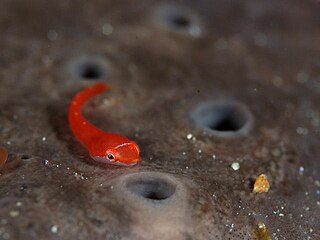
Aspasma minima is a species of clingfish found in the Pacific Ocean near the shores of southern Japan. This species grows to 5 cm (2.0 in) in standard length. This species is the only species in the monotypic genus Aspasma. This species was described in 1887 by the German zoologist and paleontologist Ludwig Heinrich Philipp Döderlein from a type collected at a depth of 100-150 fathoms in Sagami Bay, Japan.

Gobiesox is a genus of clingfishes found in the Americas, including offshore islands. Most species inhabit coastal marine and brackish waters, but G. lanceolatus is a deep-water species found at a depth of around 300 m (980 ft), and seven species are from fast-flowing rivers and streams. These seven are the only known freshwater clingfish.

The blunt-snouted clingfish is a species of clingfish found along the western Mediterranean Sea coasts from Spain to Italy. This species grows to a length of 5 centimetres (2.0 in) TL. The blunt-nosed clingfish is a little known species of shallow water along the littoral of the northern Mediterranean from Alicante to Sicily. Its range was formerly thought to extend to Israel and Syria in the east; however this was actually several closely related cryptic species. It can survive out of the water and occurs only among intertidal pebbles and sand.

Kopua is a genus of clingfishes found in the Pacific Ocean.

Lepadogaster is a genus of clingfishes native to the eastern Atlantic Ocean extending into the Mediterranean Sea. Lepadogaster belongs to class Actinopterygii. This means that they share many of the same characteristics as eels, ray-finned fish, and sea horses to name a few. The main characteristic of all of them though is having fin rays. These fin rays are made of webbed skin and are attached to portions of the body that connect fins to the bones. Lepadogaster species have a distinct difference in the formation of their dorsal and anal fins. While most other ray-finned fish spines, branched fin-rays, and middle radials, Lepadogaster species do not have these. Instead, they have cartilage in place of the mentioned features. These clingfish are mainly found near the rocky coasts and inside intertidal zones. Lepadogaster is known mostly as a clingfish, meaning that it spends most of its time attached to the surface of rocks.
The streaky clingfish is a species of clingfish only known from one specimen collected off the coast of southern Mozambique. The length of the only known specimen was 2.1 centimetres (0.83 in) SL. This species is the only known member of its genus. The single known specimen was collected at Ponte Zavora in southern Mozambique by Mrs D.N. Lusher, who sent it to J.L.B. Smith. Smith described the species from this type and named it in honour of Mrs Lusher, so the spelling should be lusherae to reflect her gender.
Pherallodiscus is a genus of clingfishes native to the central eastern Pacific Ocean along the coast of Mexico. Based on genetic studies the genus should be merged into Gobiesox.
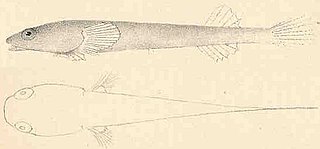
Rimicola is a genus of clingfishes found along the coasts of the eastern Pacific Ocean.

Lepadogaster candolii, common name Connemarra clingfish, is a species of fish in the genus Lepadogaster. It occurs in the Eastern Atlantic from the British Isles south to Madeira and the Canary Islands and into the western Mediterranean and the Black Sea. The specific name candolii honours the Swiss botanist Augustin Pyramus de Candolle (1778-1841) and has various spellings: candolii, candolei, candollei, and decandollii, but only the first one is correct. Some workers have found that L. candolii is not closely related to the other two species in the genus Lepadogaster and have proposed the placing of this species in the revived monotypic genus Mirbelia Canestrini, 1864, at least until more definitive taxonomic studies can be undertaken.
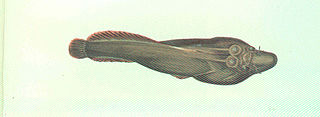
Lepadogaster purpurea, the Cornish sucker, is a species of clingfish from the family Gobiesocidae. It is found in the eastern North Atlantic Ocean and in the Mediterranean Sea.

Diplecogaster bimaculata, the two-spotted clingfish, is a species of fish in the family Gobiesocidae found in Black Sea, Mediterranean Sea and Atlantic Ocean where it is found on rocks and among seagrass or shell beds.
Gobiesox cephalus, the riverine clingfish or smooth clingfish, is a species of clingfish from the family Gobiesocidae. It is found in the coastal river drainages of the Caribbean from Cuba south to Colombia and Venezuela. It occurs in freshwater, and sometimes in brackish water, preferring a fast current. It is a solitary species which feeds on fishscales, insects and small fish. It is the type species if the genus Gobiesox and was described by Bernard Germain de Lacépède in 1800 with Amérique méridionale given as the type locality.

Lepadichthys frenatus, the bridled clingfish, is a species of clingfish from the family Gobiesocidae. It is found on shallow reefs in the western Pacific Ocean.
Opeatogenys gracilis is a species of clingfish from the family Gobiesocidae which is found in the Mediterranean Sea and in the eastern Atlantic Ocean. Suggested common names for this species are the pygmy clingfish and the seagrass clingfish.
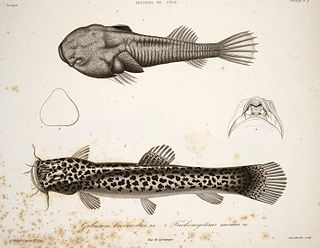
Sicyases brevirostris is a species of clingfish from the family Gobiesocidae. It is endemic to the rocky intertidal zones of the Juan Fernández Islands, Chile. It was described in 1848 as Gobiesox brevirostris by Alphone Guichenot. Fishbase treats Sicyases hildebrandi as synonymous with S. brevirostris although some authorities still treat S. hildebrandi as a valid species.
Southern California Coastal–Baja California is a freshwater ecoregion in Western North America. It covers portions of central and southern California and west of the Coast Ranges as well as most of Mexico's Baja California Peninsula, extending from the southern end of Monterey Bay to the southern tip of the Baja California Peninsula.













